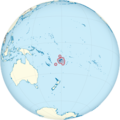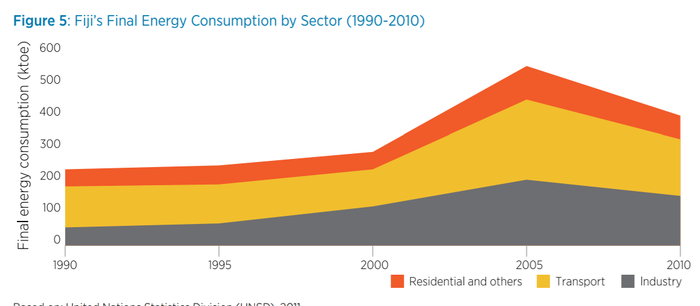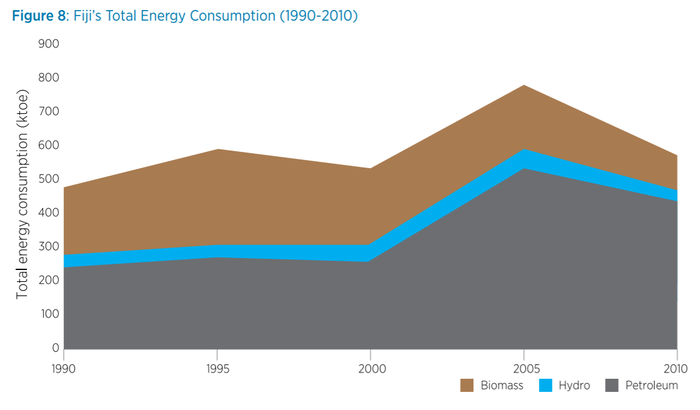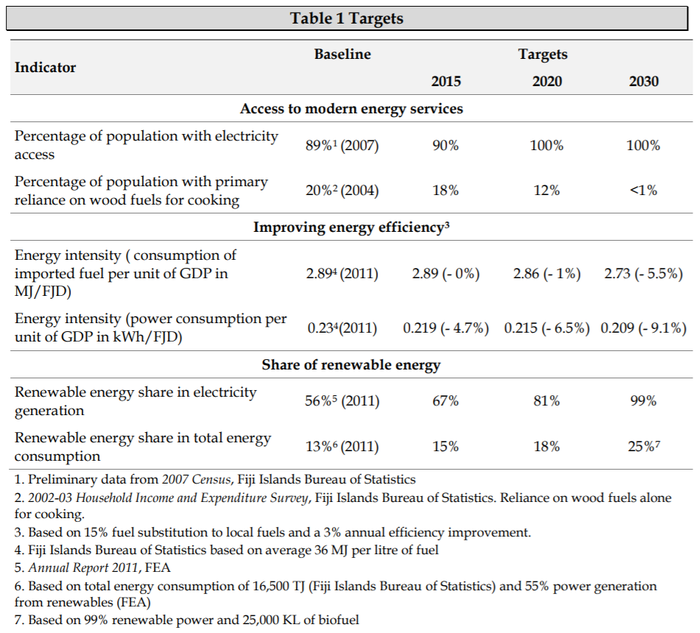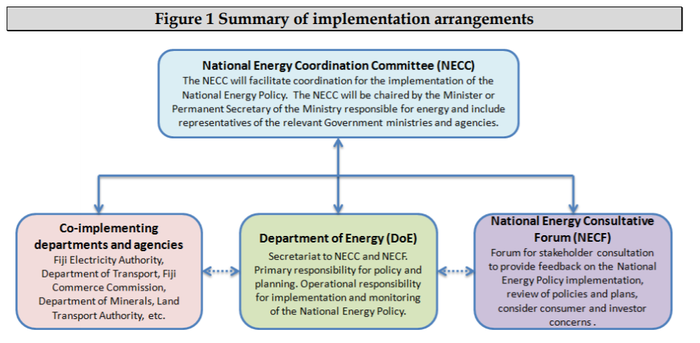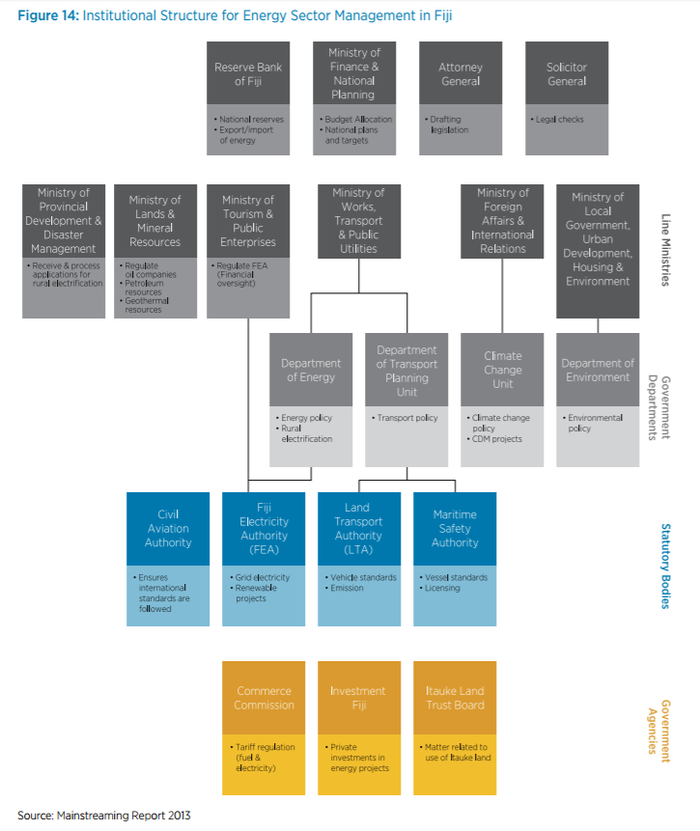Fiji Energy Situation
Capital:
Suva
Region:
Coordinates:
17.8000° S, 178.0000° E
Total Area (km²): It includes a country's total area, including areas under inland bodies of water and some coastal waterways.
18,270
Population: It is based on the de facto definition of population, which counts all residents regardless of legal status or citizenship--except for refugees not permanently settled in the country of asylum, who are generally considered part of the population of their country of origin.
929,766 (2022)
Rural Population (% of total population): It refers to people living in rural areas as defined by national statistical offices. It is calculated as the difference between total population and urban population.
42 (2022)
GDP (current US$): It is the sum of gross value added by all resident producers in the economy plus any product taxes and minus any subsidies not included in the value of the products. It is calculated without making deductions for depreciation of fabricated assets or for depletion and degradation of natural resources.
4,979,979,546 (2022)
GDP Per Capita (current US$): It is gross domestic product divided by midyear population
5,356.16 (2022)
Access to Electricity (% of population): It is the percentage of population with access to electricity.
92.10 (2021)
Energy Imports Net (% of energy use): It is estimated as energy use less production, both measured in oil equivalents. A negative value indicates that the country is a net exporter. Energy use refers to use of primary energy before transformation to other end-use fuels, which is equal to indigenous production plus imports and stock changes, minus exports and fuels supplied to ships and aircraft engaged in international transport.
no data
Fossil Fuel Energy Consumption (% of total): It comprises coal, oil, petroleum, and natural gas products.
0.00 (2007)
Introduction
Fiji is a Small Island Developing State (SID) with over 300 small islands and a population of almost 900,000 (2016)[1]. The majority of Fiji‟s population live on the two main islands of Viti Levu and Vanua. [2]
Energy Situation
In 2015, the country’s total installed electricity generation capacity was 296 megawatts, of which the Fiji National Electricity Authority operated 94%. Of this capacity, 254 megawatts was grid connected.[3]
Like for many other SIDs Fiji’s geographical situation means that affordable and accessible energy supply is a challenge. The Island state depends heavily on imported fossil fuel to meet its energy needs, nevertheless, renewable energy sources, mainly hydro, account for 55% of the country’s total energy production.[1] [4]
Energy access rates in Fiji have increased, however, 4% of urban residents and nearly 20% of rural dwellers still lack electricity.[3] Even in areas with grid connection, high costs and inequalities within communities, prevent some parts of the population from achieving reliable access to electricity. [2]
Renewable Energy
In 2014, 55% of Fiji’s electricity was generated using renewable energy resources, making it the island state in the entire Pacific with the lowest oil dependency. In fact, on several of Fiji’s larger islands 60% of electricity comes from hydropower and biomass. On the smaller islands Solar Home Systems (SHS) are used to provide access to electricity for the inhabitants. [4] Fiji has abundant natural renewable energy resources and numerous recent assessments have shown that a combination of solar, wind, geothermal, marine, biomass and bio-fuel could be used to meet the islands domestic energy needs while simultaneously decreasing electricity coast, increasing energy access and boosting the state’s energy independence. [5]
Currently hydro power accounts for a large proportion of Fiji’s renewable energy generating. However, scaling up other renewable energy technologies, such as solar, would diversify state’s energy mix and thereby help improve energy security. Solar PV and battery storage hybrid systems could also be used to improve the stability of the many existing mini-grids in the country.
Fossil Fuel
Fiji depends heavily on imported fossil fuels. This results in high energy prices as well as having a negative impact on the nation’s energy security. [5] In 2016 Fuel imports accounted for 16% of Fiji’s total national import bill (US$ 346 million). Most of this fuel, mainly gasoline, oil and aviation turbine fuel, is consumed by the transport sector.[1]
Fuel Prices
For the latest government commerce commission on petroleum please look here
Key Problems of the Energy Sector
Some of the main challenges in nations energy sector arise from an institution and policy framework which includes overlaps in responsibilities as well as significant gaps in terms of coordination, regulation and oversight. In 2013 the National Energy Policy identified these factors as the main problems within Fiji’s energy sector:
- Lack of coordination of the various public-sector institutions with responsibilities in the energy sector;
- Lack of an institution with overall responsibility for energy planning and policy development;
- Lack of effective sharing and management of energy information;
- Lack of transparency in the manner in which prices have been set;
- No encouragement for significant private sector participation in the energy sector as a result of a lack of a clear regulatory frameworks and resource information not being made public as well as a general weakness in Fiji‟s business climate.[2]
Policy Framework, Laws and Regulations
The government of Fiji is very much in support of renewable energy sources and is actively seeking partners in the energy sector which will help the country increase its renewable energy generation capacity, as well as develop the island state’s transmission and distribution infrastructure, both in urban and rural areas. Policies are in place to promote off-grid energy generation for rural areas, such as SHS, solar powered water supply systems, solar water heating systems and solar systems for schools and clinics.[1]
“Overall, the government of Fiji is strongly committed to the global effort to address climate change”. The island nation is organising the COP23 in 2017 (the United Nation’s annual climate conference). Furthermore, the country has set itself the target of achieving 100% renewable electricity generation by 2030. In the national energy policy the government has recognized the need to “act now to reduce the reliance on imported fossil fuels through renewable energy while increasing the efficiency of use of current fossil fuel supplies.” [2]
The National Energy Policy of the country states that Fiji could achieve 100% renewable electricity by 2030, however, this would require an increase in action, such as a strict implementation of the National Energy Policy, improved coordination between agencies as well as investing in new energy technologies such as renewable-powered maritime transport and geothermal energy. [4]
The full 2013-2020 Fiji National Energy Policy can be accesses here
Institutional Set up in the Energy Sector
Further Information
- Fuel prices Fiji
- Fuel Price Data Fiji
- Small Island Developing States
- Fiji National Energy Policy 2013 - 2020
- An Economic Assessment of Renewable Energy Options for Rural Electrification in Pacific Island Countries
- Renewable Readiness Assessment: Fiji
- Fiji, Venuatu and the Marshall Islands Can Win Big with Renewables
- Solar Supports Village Livelihoods and Spurs Business in Fiji
- A review of Fiji's energy situation: Challenges and strategies as a small island developing state
References
- ↑ 1.0 1.1 1.2 1.3 export.gov, 2017. Fiji - Energy [WWW Document]. URL https://www.export.gov/article?id=Fiji-Energy (accessed 11.10.17).
- ↑ 2.0 2.1 2.2 2.3 Government of Fiji, 2013. Fiji National Energy Policy.
- ↑ 3.0 3.1 Chen, Y., Gönül, G., Zieroth, G., 2015. Fiji Renewable Readiness Assessment. Abu Dabi.
- ↑ 4.0 4.1 4.2 IRENA, 2017a. Solar Supports Village Livelihoods and Spurs Business in Fiji [WWW Document]. /newsroom/articles/2017/Oct/Solar-Supports-Village-Livelihoods-and-Spurs-Business-in-Fiji. URL http://www.irena.org/newsroom/articles/2017/Oct/Solar-Supports-Village-Livelihoods-and-Spurs-Business-in-Fiji (accessed 11.10.17).
- ↑ 5.0 5.1 IRENA, 2017b. Fiji, Vanuatu and the Marshall Islands Can Win Big with Renewables [WWW Document]. /newsroom/articles/2015/Jul/Fiji-Vanuatu-and-the-Marshall-Islands-Can-Win-Big-with-Renewables. URL http://www.irena.org/newsroom/articles/2015/Jul/Fiji-Vanuatu-and-the-Marshall-Islands-Can-Win-Big-with-Renewables (accessed 11.10.17).


